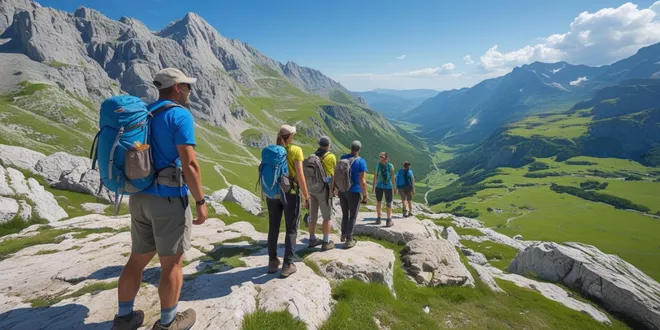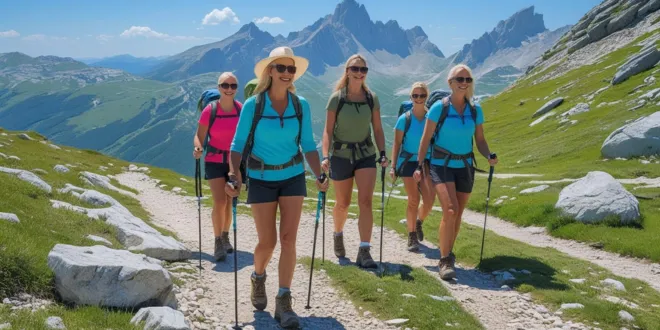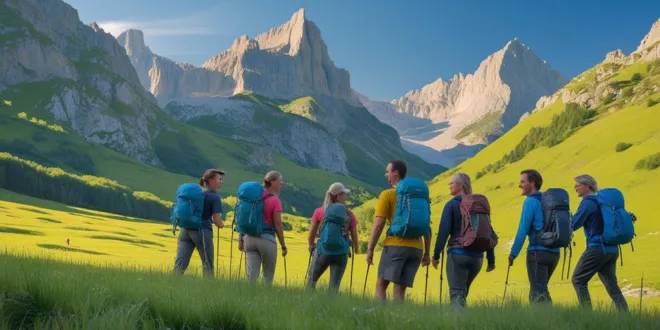Hiking in the French Pyrenees offers an unforgettable adventure through one of Europe’s most breathtaking mountain ranges. Stretching from the Atlantic Ocean to the Mediterranean Sea, the French side of the Pyrenees is renowned for its dramatic peaks, lush valleys, crystal-clear lakes, and rich biodiversity.
Whether you’re a seasoned trekker or a nature-loving beginner, hiking in the French Pyrenees promises diverse trails that cater to all levels of experience. From short day hikes to multi-week expeditions, this region is a paradise for outdoor enthusiasts.
In this complete guide to hiking the French Pyrenees, you’ll discover everything you need to know—from the best seasons to visit and essential gear, to detailed trail descriptions and cultural highlights.
Wondering when to hike the French Pyrenees? Summer (June to September) is ideal, offering mild weather and accessible high-altitude routes. Among the most iconic long-distance paths is the GR10 Trail, which traverses the entire French side of the range and provides unparalleled views and immersion in local Pyrenean culture.
For those seeking a more challenging trek, the Haute Route Pyrenees offers a high-level journey linking legendary peaks like Vignemale and Pic du Midi.
And if you’re deciding between destinations, our comparison of French Pyrenees vs. Spanish Pyrenees: which side is better for hiking? will help you choose. We’ll also highlight the best hiking trails in the French Pyrenees and reveal the top 10 must-do hikes in the French Pyrenees, ensuring your journey is as rewarding as it is scenic.

Hiking in the French Pyrenees
The French Pyrenees offer breathtaking alpine scenery, from rugged peaks and deep valleys to lush meadows and glacial lakes. This mountain range, stretching along the border between France and Spain, provides diverse hiking opportunities for all levels.
Trails wind through protected areas like the Pyrénées National Park, home to native wildlife such as ibex and marmots. Hikers enjoy well-marked paths, charming mountain refuges, and picturesque villages like Cauterets and Luz-Saint-Sauveur.
The region blends natural beauty with rich cultural heritage, including Basque and Occitan influences. Whether you’re seeking a day hike to a panoramic summit or a multi-day trek, the French Pyrenees deliver unforgettable experiences.
The climate is generally mild in summer, making it ideal for hiking from June to September. With relatively fewer crowds than the Alps, this region is perfect for those looking for solitude and serenity in nature.
Proper preparation is key, as weather can change quickly at altitude. From gentle forest walks to challenging high-mountain routes, the French Pyrenees are a hiker’s paradise combining adventure, beauty, and tranquility.
Best Hiking Trails in the French Pyrenees
The French Pyrenees boast some of Europe’s most scenic and diverse hiking trails. Among the top routes is the GR10, which traverses the entire mountain range from the Atlantic to the Mediterranean, offering hikers a deep immersion in alpine landscapes and local culture.
The Cirque de Gavarnie, a UNESCO World Heritage site, features a dramatic natural amphitheater and a towering waterfall, making it a must-see. The Pic du Midi d’Ossau hike rewards climbers with panoramic views of jagged peaks and emerald valleys.
For a high-mountain experience, the Tour du Vignemale circles one of the range’s highest peaks, passing glaciers and alpine lakes. Shorter but equally stunning hikes include the Lac de Gaube and the Valley of Campan, both accessible and family-friendly.
Trails often pass through flower-filled meadows, ancient forests, and traditional stone shepherd huts. Well-marked paths and mountain refuges make multi-day treks feasible.
Whether you’re after a challenging ascent or a peaceful valley walk, these trails showcase the natural grandeur of the French Pyrenees. With clean air, rich biodiversity, and stunning vistas, each route offers a unique way to connect with nature in one of France’s most beautiful wilderness areas.
Complete Guide to Hiking the French Pyrenees
Hiking in the French Pyrenees is a rewarding adventure for outdoor enthusiasts of all levels. This mountain range offers a mix of gentle valley walks and challenging high-altitude treks, all set against a backdrop of dramatic peaks, glacial lakes, and lush forests.
The best time to hike is from June to September when trails are snow-free and weather is stable. The GR10 is the region’s most famous long-distance trail, stretching over 900 km from Hendaye to Banyuls-sur-Mer, passing through national parks and remote villages.
Other highlights include the Cirque de Gavarnie, Pic du Midi d’Ossau, and the Vignemale massif. Mountain refuges (refuges gardés) provide basic accommodation for multi-day hikes. Navigation is generally easy with well-marked trails, though a map and compass or GPS are recommended.
Pack for variable weather—even in summer, conditions can change rapidly. Public transport connects many trailheads, and local tourist offices offer updated trail information.
The region is rich in flora and fauna, including marmots, chamois, and golden eagles. With fewer crowds than the Alps and a blend of French and Pyrenean culture, the French Pyrenees offer a peaceful, immersive hiking experience.
Whether you’re planning a day hike or a week-long trek, this guide helps you explore one of Europe’s most beautiful and underrated mountain regions.

Top 10 Must-Do Hikes in the French Pyrenees
- GR10 (Full or Section Hikes)
- Cirque de Gavarnie
- Pic du Midi d’Ossau
- Tour du Vignemale
- Lac de Gaube
- Valley of Campan (Luz-Saint-Sauveur to Espèche)
- Cirque de Troumouse
- Cirque d’Estaubé
- Refuge des Sarradets via Brèche de Roland
- Aas Valley Loop
GR10 (Full or Section Hikes)
The GR10 is a legendary long-distance trail spanning the French Pyrenees. Hike the full 900 km or choose scenic sections. Well-marked and diverse, it offers mountain vistas, lush valleys, and charming villages—perfect for multi-day treks or shorter hikes in nature.
Cirque de Gavarnie
A UNESCO World Heritage site, this massive natural amphitheater features towering cliffs and Europe’s tallest waterfall. An easy hike leads to the base, offering stunning views. One of the most iconic and accessible natural wonders in the Pyrenees—great for families and photographers.
Pic du Midi d’Ossau
This iconic, helmet-shaped peak is a symbol of the western Pyrenees. The challenging hike rewards with panoramic views of rugged mountains and valleys. Best attempted in summer, it’s ideal for experienced hikers seeking solitude and breathtaking alpine scenery.
Tour du Vignemale
A multi-day high-mountain circuit around the Vignemale, the highest peak in the French Pyrenees. Pass glaciers, alpine lakes, and refuges. Requires good fitness and preparation. Offers dramatic views and a true wilderness experience in one of the range’s most spectacular zones.
Lac de Gaube
An easy, scenic hike from Cauterets leads to this stunning alpine lake with reflections of the Vignemale. Family-friendly and well-maintained, it’s perfect for a half-day outing. Arrive early to avoid crowds and enjoy peaceful views in a pristine mountain setting.
Valley of Campan (Luz-Saint-Sauveur to Espèche)
A gentle trail through the lush Campan Valley, featuring waterfalls, meadows, and wildlife. Ideal for beginners and families. Offers beautiful views and a peaceful escape into nature. Well-marked and accessible, with options to extend into higher mountain routes.
Cirque de Troumouse
One of the most accessible glacial cirques, perfect for families and casual hikers. Lush meadows in summer, snow-covered in winter. Offers panoramic views of sheer cliffs and great photo opportunities. Less crowded than Gavarnie but equally impressive in natural beauty.
Cirque d’Estaubé
Near Gavarnie, this quieter cirque offers dramatic cliffs and a powerful waterfall. A moderate hike leads through alpine terrain with fewer crowds. Best visited in summer when snowmelt enhances the falls. A hidden gem for those seeking beauty and tranquility in high mountains.
Refuge des Sarradets via Brèche de Roland
A challenging high-mountain route to a remote refuge with views of the Brèche de Roland—a legendary natural arch. Requires experience and early start. Offers dramatic landscapes, glaciers, and a sense of adventure. Not for beginners; best in late summer.
Aas Valley Loop
A peaceful, family-friendly loop through forest trails and riverside paths. Lush greenery, waterfalls, and fresh mountain air make it ideal for a relaxing day hike. Well-marked and close to Luz-Saint-Sauveur, it’s perfect for beginners or a gentle nature walk.
GR10 Trail Guide
- Route: Runs 900+ km along the French side of the Pyrenees, from Hendaye (Atlantic) to Banyuls-sur-Mer (Mediterranean)
- Duration: 45–60 days for the full trail; popular to hike in sections
- Best Sections: Pyrénées-Atlantiques, Hautes-Pyrénées (Gavarnie, Vignemale), Ariège (Andorra border)
- Difficulty: Moderate to challenging, with significant elevation changes
- Markings: Red and white blazes; well-maintained and clearly signed
- Accommodation: Mountain refuges (gardés), gîtes, and small villages
- Best Time to Hike: Mid-June to mid-September
- Highlights: Cirque de Gavarnie, Pic du Midi d’Ossau, Vignemale Glacier, Basque and Occitan villages
- Gear: Sturdy boots, layered clothing, rain gear, map/GPS (some remote areas)
- Transport: Trailheads accessible by train, bus, or car; resupply points in towns along the way
- Tips: Book refuges in advance in peak season; be prepared for sudden weather changes
When to Hike the French Pyrenees
The best time to hike in the French Pyrenees is from June to September, when most trails are snow-free and weather conditions are generally stable. July and August are the warmest months, ideal for high-altitude treks, but also the busiest, especially around popular spots like Cirque de Gavarnie.
June offers blooming wildflowers and fewer crowds, though some higher passes may still have snow early in the month. September is often considered the perfect window—cooler temperatures, golden autumn light, and lingering clear skies, with fewer hikers on the trails. Spring (April–May) is possible in lower valleys, but higher elevations remain snowy and dangerous.
Winter hiking is reserved for experienced mountaineers due to avalanche risks and extreme conditions. Always check local trail reports and weather forecasts before setting out, as mountain weather can change rapidly.
Early mornings are best for avoiding afternoon thunderstorms in summer. If you’re planning a long-distance trek like the GR10, starting in late June allows you to finish before autumn storms arrive.
With proper timing, the French Pyrenees offer safe, scenic, and deeply rewarding hiking experiences throughout the summer season.
Haute Route Pyrenees
The Haute Route Pyrenees, also known as the Haute Randonnée Pyrénéenne (HRP), is one of the most challenging and scenic long-distance hikes in Europe. Unlike the GR10, which follows the foothills, the HRP sticks to the high mountain ridge, traversing remote passes, glaciers, and alpine terrain close to the French-Spanish border.
Stretching approximately 800 kilometers from Hendaye to Banyuls-sur-Mer, the route demands strong navigation skills, excellent fitness, and mountaineering experience due to its rugged, often unmarked paths.
Hikers pass through dramatic landscapes—sheer cliffs, snowfields, and pristine valleys—often above 2,500 meters. The trail crosses iconic areas like the Néouvielle Massif, Vignemale, and Aneto Peak (on the Spanish side).
Unlike the GR10, there are fewer refuges, so backpacking gear and self-sufficiency are essential. The best time to attempt the HRP is mid-July to early September, when snow levels are lowest.
While less traveled, the HRP offers unparalleled solitude and raw alpine beauty. It’s ideal for experienced hikers seeking adventure beyond standard trails. With minimal signage and unpredictable weather, thorough preparation is crucial.
The Haute Route is not just a hike—it’s a true wilderness expedition through the heart of the Pyrenees, rewarding those who take the challenge with some of the most breathtaking mountain scenery in Europe.
French Pyrenees vs. Spanish Pyrenees: Which Side is Better for Hiking?
Choosing between the French and Spanish Pyrenees depends on your hiking style and preferences. The French side is known for its well-maintained trails, charming villages, and excellent infrastructure, including guarded mountain refuges (refuges gardés) and clear trail markings—ideal for hikers seeking comfort and accessibility.
Scenery is dramatic but often more rounded, with lush valleys and flower-filled meadows. Popular routes like the GR10 and Cirque de Gavarnie are easily accessible and family-friendly.
In contrast, the Spanish Pyrenees offer a wilder, more rugged experience. Trails are less crowded, higher in elevation, and closer to dramatic peaks like Aneto. The Spanish side features more alpine terrain, glaciers, and remote landscapes, appealing to experienced hikers. However, infrastructure is sparser, with fewer manned refuges and less signage.
The French side tends to be more tourist-oriented with better public transport, while the Spanish side provides greater solitude and adventure.
Culturally, the French side blends Basque and Occitan influences, while the Spanish side features Aragonese traditions. For beginners or those wanting comfort, the French Pyrenees are better.
For seasoned trekkers seeking challenge and wilderness, the Spanish side wins. Ultimately, combining both offers the most complete Pyrenean experience.

conclusion
In conclusion, hiking in the French Pyrenees is a truly rewarding experience that combines stunning alpine scenery, diverse wildlife, and rich cultural heritage. Whether you’re planning a short weekend escape or a long-distance trek, this region offers some of the most spectacular trails in Europe. From serene mountain lakes to rugged high-altitude passes, the best hiking trails in the French Pyrenees cater to adventurers of all levels.
This complete guide to hiking the French Pyrenees has covered essential topics like the ideal conditions, necessary gear, and how to plan your journey. We’ve explored the top 10 must-do hikes in the French Pyrenees, highlighting iconic routes that showcase the region’s natural beauty. For long-distance hikers, the GR10 Trail Guide provides valuable insights into this legendary path that runs the length of the French Pyrenees, offering consistent challenges and breathtaking views.
If you’re drawn to high-mountain trekking, the Haute Route Pyrenees presents a more demanding but deeply rewarding adventure across glacial landscapes and remote ridges. And for those deciding between destinations, our comparison of French Pyrenees vs. Spanish Pyrenees: which side is better for hiking? helps clarify the unique advantages of each—whether it’s easier access, better signage, or wilder terrain.
Knowing when to hike the French Pyrenees—typically between June and September—is key to a safe and enjoyable trip. With proper planning and this guide in hand, your journey through the French Pyrenees will be not only memorable, but truly transformative.
Frequently asked questions
1. What is the best time to hike in the French Pyrenees?
The best time to hike in the French Pyrenees is from late June to early September, when snow has melted and mountain refuges are open. July and August offer the most stable weather and accessible high passes, though they’re also the busiest. Early September is ideal for fewer crowds and still-good conditions.
2. How difficult is hiking in the French Pyrenees?
Hiking difficulty in the French Pyrenees ranges from moderate to challenging. While day hikes are manageable for most, long-distance trails like the GR10 or Haute Route involve steep ascents, rugged terrain, and variable weather. Good fitness, experience with navigation, and preparation for altitude changes are essential for a safe and enjoyable trek.
3. What are the best hiking trails in the French Pyrenees?
Top trails include the GR10, Haute Route Pyrenees, Cirque de Gavarnie, Lac de Gaube, and the Vignemale Massif. These offer stunning alpine scenery, glacial valleys, and well-maintained paths. Whether you seek day hikes or multi-week adventures, these routes highlight the region’s natural beauty and cultural charm.
4. Is the GR10 trail well-marked and safe for solo hikers?
Yes, the GR10 is well-marked with red-and-white blazes and generally safe for solo hikers. It’s popular among international trekkers, with frequent access to villages and mountain refuges. However, remote sections require navigation skills, self-reliance, and awareness of weather changes, especially at high elevations.
5. Do I need a guide to hike the Haute Route Pyrenees?
A guide isn’t mandatory for the Haute Route Pyrenees, but it’s recommended for less experienced hikers. The route involves off-trail navigation, glacier crossings, and exposed ridges. If you’re confident in alpine terrain and navigation, you can go solo. Many opt for guided tours for safety and logistical support.
6. Are there mountain huts (refuges) on French Pyrenees trails?
Yes, there are numerous mountain huts (refuges) along major trails in the French Pyrenees. Most are staffed in summer (June–September), offering basic dormitory lodging, meals, and water. Reservations are advised. They provide essential shelter and reduce the need to carry heavy camping gear on long-distance treks.
7. Can beginners hike in the French Pyrenees?
Yes, beginners can enjoy hiking in the French Pyrenees by choosing well-marked, lower-altitude day hikes like Lac de Gaube or Cirque de Gavarnie. These require moderate fitness but no technical skills. However, long-distance or high-mountain routes demand experience, so novices should start small and gradually build up.
8. What gear do I need for hiking in the French Pyrenees?
Essential gear includes sturdy hiking boots, layered clothing, a waterproof jacket, backpack, map/compass or GPS, first-aid kit, headlamp, and food/water supplies. For multi-day hikes, consider a tent or booking refuge stays. Weather changes fast, so always pack for cold, wind, and rain—even in summer.
9. How long does it take to hike the GR10 trail?
The GR10 trail spans approximately 900 km (560 miles) from the Atlantic to the Mediterranean. Most hikers complete it in 5 to 7 weeks, averaging 20–25 km per day. The duration depends on fitness, weather, and rest days. Thru-hiking is common, but many choose to hike sections over multiple trips.
10. Is wild camping allowed in the French Pyrenees?
Wild camping is tolerated in remote areas of the French Pyrenees but restricted in national parks like Pyrénées National Park. It’s generally allowed above the tree line if done discreetly, quietly, and without overnight fires. However, using designated campsites or refuges is encouraged and often required near popular trails.

